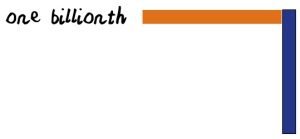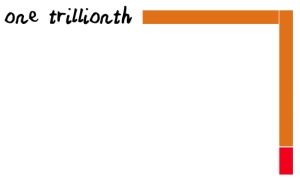Here we go….however just before we begin the descent, I would like to claim that as far as I know, the following kind of representation has not been done before. I stress ‘as far as I know’, so apologies to anyone who has. I may be up for a Nobel Prize…whoa!
Instead of the rod power towers going up, they could of course go down. They’d be subterranean establishments like secret government underground levels where they interrogate aliens and hide their nuclear mission control nodes.
Towers that ‘go down’ are a bit hard to do with real rods unless you had good glue and worked underneath the table, however they can be represented if we use the standard L form for towers layed down flat on a surface then go the other way like this:
10 to the minus 12th, that’s how you say it.
The minus sign is a bit upsetting, but just think of it as making the power towers go down. The other way to think about this is to understand that its a short hand way of writing down the fractions, one thousandth, one millionth etc. i.e. it is one whole one reduced in size by a thousandth or a millionth. Another way is to understand that its one whole divided by a hundred, a thousand or a million. Look, here’s one hundredth:
 this is the same as
this is the same as  or it can be
or it can be 
They’re different ways of writing down the same thing.
Look here,
for millionth you say micro, for example you could say a micrometre – an anthrax spore is about 6 micrometres across.
for billionth you say nano, for example a nanometre, a billionth of a metre – the diameter of a ribosome is about 20 nanometres.
for trillionth you say pico, you could say 6 picometres, 6 trillionths of a metre – an average atom is about 100 picometres in diameter.
Then you get, femto, atto, zepto and yocto.
One yoctometre is 10 raised to the power -24
A squillionth of an inch is half a grain of spacetime.







